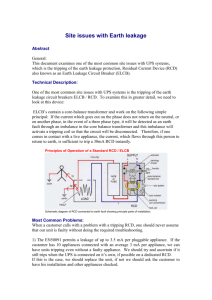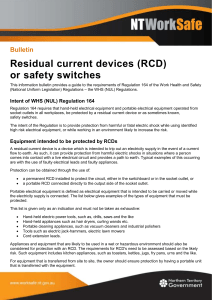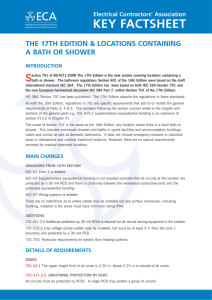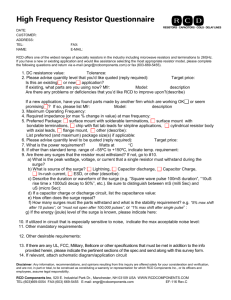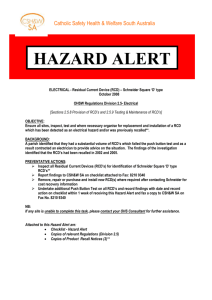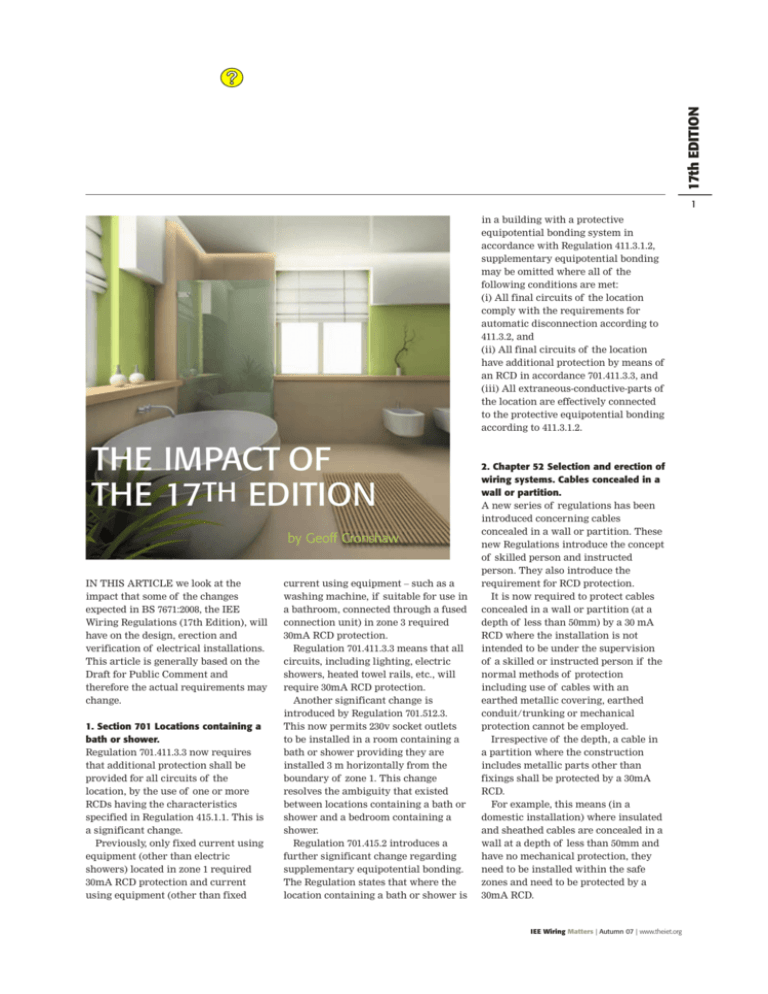
17th EDITION
1
in a building with a protective
equipotential bonding system in
accordance with Regulation 411.3.1.2,
supplementary equipotential bonding
may be omitted where all of the
following conditions are met:
(i) All final circuits of the location
comply with the requirements for
automatic disconnection according to
411.3.2, and
(ii) All final circuits of the location
have additional protection by means of
an RCD in accordance 701.411.3.3, and
(iii) All extraneous-conductive-parts of
the location are effectively connected
to the protective equipotential bonding
according to 411.3.1.2.
THE IMPACT OF
THE 17TH EDITION
by Geoff Cronshaw
IN THIS ARTICLE we look at the
impact that some of the changes
expected in BS 7671:2008, the IEE
Wiring Regulations (17th Edition), will
have on the design, erection and
verification of electrical installations.
This article is generally based on the
Draft for Public Comment and
therefore the actual requirements may
change.
1. Section 701 Locations containing a
bath or shower.
Regulation 701.411.3.3 now requires
that additional protection shall be
provided for all circuits of the
location, by the use of one or more
RCDs having the characteristics
specified in Regulation 415.1.1. This is
a significant change.
Previously, only fixed current using
equipment (other than electric
showers) located in zone 1 required
30mA RCD protection and current
using equipment (other than fixed
current using equipment – such as a
washing machine, if suitable for use in
a bathroom, connected through a fused
connection unit) in zone 3 required
30mA RCD protection.
Regulation 701.411.3.3 means that all
circuits, including lighting, electric
showers, heated towel rails, etc., will
require 30mA RCD protection.
Another significant change is
introduced by Regulation 701.512.3.
This now permits 230v socket outlets
to be installed in a room containing a
bath or shower providing they are
installed 3 m horizontally from the
boundary of zone 1. This change
resolves the ambiguity that existed
between locations containing a bath or
shower and a bedroom containing a
shower.
Regulation 701.415.2 introduces a
further significant change regarding
supplementary equipotential bonding.
The Regulation states that where the
location containing a bath or shower is
2. Chapter 52 Selection and erection of
wiring systems. Cables concealed in a
wall or partition.
A new series of regulations has been
introduced concerning cables
concealed in a wall or partition. These
new Regulations introduce the concept
of skilled person and instructed
person. They also introduce the
requirement for RCD protection.
It is now required to protect cables
concealed in a wall or partition (at a
depth of less than 50mm) by a 30 mA
RCD where the installation is not
intended to be under the supervision
of a skilled or instructed person if the
normal methods of protection
including use of cables with an
earthed metallic covering, earthed
conduit/trunking or mechanical
protection cannot be employed.
Irrespective of the depth, a cable in
a partition where the construction
includes metallic parts other than
fixings shall be protected by a 30mA
RCD.
For example, this means (in a
domestic installation) where insulated
and sheathed cables are concealed in a
wall at a depth of less than 50mm and
have no mechanical protection, they
need to be installed within the safe
zones and need to be protected by a
30mA RCD.
IEE Wiring Matters | Autumn 07 | www.theiet.org
17th EDITION
2
3. Chapter 41 Protection against
electric shock.
3.1 socket-outlets
Chapter 41 now requires in Regulation
411.3.3 that for the protective measure
of automatic disconnection of supply
for an a.c. system, additional
protection by means of a 30 mA RCD
shall be provided for socket-outlets
with a rated current not exceeding
20A that are for use by ordinary
persons. The 17th Edition defines an
ordinary person as “a person who is
neither a skilled person nor an
instructed person”.
An exception is permitted for socketoutlets for use under the supervision of
skilled or instructed persons, The 17th
Edition defines a skilled person as “a
person with technical knowledge or
sufficient experience to enable him/her
to avoid dangers which electricity may
create”. An instructed person is defined
as “a person adequately advised or
supervised by skilled persons to enable
him/her to avoid dangers which
electricity may create”. Therefore this
exception would apply, for example, in
some commercial or industrial
locations.
A further exception is permitted for
a specific labelled or otherwise
suitably identified socket-outlet
provided for connection of a
particular item of equipment. This,
for example, could be a socket outlet
for a freezer in a domestic kitchen.
However, the Regulations require
that an RCD shall be so selected and
the electrical circuits so subdivided
that any protective conductor current
which may be expected to occur
during normal operation of the
connected load(s) will be unlikely to
cause unnecessary tripping of the
device. For example, this could mean
the installation of RCBOs instead of
Split Load consumer units in a
domestic installation.
This requirement is a significant
change from the 16th Edition which
had fewer requirements for RCD
protection, for example, these were:
supplementary protection in every
circuit likely to supply portable
equipment for use outdoors, and
indirect shock protection where the
earth fault loop impedance (Zs) is
insufficiently low to operate a fuse or
circuit-breaker within the prescribed
time.
3.2 Disconnection times.
Chapter 41 now requires that final
circuits not exceeding 32 A shall have
a disconnection time not exceeding 0.4
seconds for a TN system with, for
example, a nominal voltage to earth of
230 volts. For a TT system, this is
further reduced to a 0.2 second
disconnection time.
However, with regard to TT systems,
a statement is inluded with Table 41.1,
Maximum disconnection times:-
"Where disconnection is achieved by
an overcurrent protective device, and
the protective equipotential bonding,
or main equipotential bonding, is
correctly installed, the maximum
disconnection times applicable to a
TN system may be used."
With regard to TN systems, users of
the Regulations will note that where
the overcurrent protective device is a
circuit-breaker, such as a device to
BS EN 60898 and the earth fault loop
impedance Zs is not greater than the
values given in Table 41.3, the circuit
will disconnect within 0.4 seconds
then the requirements of the 17th
Edition of BS 7671 will be met.
This reduction in disconnection time
is a significant change from the 16th
Edition. The current Edition requires
that a circuit supplying socket-outlets,
for example, shall have a 0.4 second
disconnection time compared to a
circuit supplying stationary equipment
which must have a disconnection time
not exceeding 5 s (413-02-13).
4.0 Voltage drop in consumers’
installations.
Chapter 52 introduces changes in the
maximum value of voltage drop
permitted and makes a clear division
between the requirements of an
installation supplied from a public LV
supply and a private LV supply.
The first two Regulations require
that the voltage at the terminals of
Wiring Matters is produced by IET Services Limited, a subsidiary of The Institution of Engineering and Technology (IET), for the IET.
Michael Faraday House, Six Hills Way, Stevenage, Herts, SG1 2AY, United Kingdom Tel: +44 (0)1438 313311 Fax: +44 (0)1438 313465
Sales and Project Coordinator L Hall +44 (0)1438 767351 lhall@theiet.org | Editor G D Cronshaw +44 (0)1438 767384
gcronshaw@theiet.org | Contributing Editors M Coles, J Elliott, J Ware | Design Sable Media Solutions
IEE Wiring Matters is a quarterly publication from the Institution of Engineering and Technology (IET). The IET is not as a body responsible for
the opinions expressed.
©2007: The Institution of Engineering and Technology. All rights reserved. No part of this publication may be reproduced, stored in a retrieval
system, or transmitted in any form or by any means without the permission in writing of the publisher. Copying of articles is not permitted
except for personal and internal use. Multiple copying of the content of this publication without permission is always illegal. Web-offset
printing by Wyndeham Heron, The Bentall Complex, Colchester Road, Heybridge, Maldon, Essex, UK
Co-operating Organisations The Institution of Engineering & Technology acknowledges the contribution made by the following
organisations in the preparation of this publication: British Electrotechnical & Allied Manufacturers Association Ltd – R Lewington,
P D Galbraith, M H Mullins | Department for Communities and Local Government – I Drummond | Electrical Contractors Association – D Locke,
S Burchell | City & Guilds of London Institute – H R Lovegrove | Energy Networks Association – D J Start | Electrical Contractors Association
of Scotland SELECT – D Millar, N McGuiness | Health & Safety Executive – K Morton | Electrical Safety Council | ERA Technology Limited –
M Coates | British Cables Association – C Reed | Scottish Building Standards Agency | DTI – D Tee | CORGI – P Collins | GAMBICA –
K Morris.
ISSN 1749-978-X
IEE Wiring Matters | Autumn 07 | www.theiet.org
PWRRFP73
17th EDITION
4
any fixed current-using equipment
shall be greater than the lower limit
corresponding to the product standard
relevant to the equipment or in the
absence of a standard shall not to
impair the safe functioning of that
equipment; this is the same as the 16th
Edition requirement.
The new Regulations recognise that
the voltage drop requirements will be
satisfied if the voltage drop between
the origin of the installation (usually
the supply terminals) and a socketoutlet or the terminals of fixed
current-using equipment does not
exceed that stated in Appendix 12.
This Appendix gives a maximum
value of 3% for lighting and 5% for
other uses for a low voltage
installation supplied directly from a
public low voltage distribution system.
This is the most common situation.
For a low voltage installation,
supplied directly from a private LV
supply, the appendix gives a maximum
value of 6% for lighting and 8% for
other uses.
This is a significant change from
IEE Wiring Matters | Autumn 07 | www.theiet.org
the 16th Edition which permitted a
maximum value of 4% voltage drop,
irrespective of whether the
installation was supplied from a public
or private supply.
5.0 Section 702 - Swimming pools and
other basins
Section 702 now includes basins of
fountains, zones A, B and C in the 16th
Edition are replaced by zones 0, 1 and
2 (however the actual zones remain the
same) and a solution is included for
the installation of 230 volt luminaires
for swimming pools where there is no
zone 2 (previously zone c).
The 17th Edition states that for
swimming pools where there is no
zone 2, lighting equipment supplied by
other than a SELV source at 12 V a.c
rms or 30 V ripple-free d.c. may be
installed in zone 1 on a wall or on a
ceiling provided that the following
requirements are fulfilled:
the circuit is protected by automatic
disconnection of the supply and
additional protection is provided by
an RCD having the characteristics
specified in Regulation 415.1.1, and
the height from the floor is at least
2 m above the lower limit of zone 1.
In addition, every luminaire shall
have an enclosure providing Class II
or equivalent insulation and providing
protection against mechanical impact
of medium severity.
This is a significant change from the
16th Edition which only allowed SELV
luminaires in zones A and B. It is not
usually practicable to provide general
illumination in a swimming pool by
means of SELV luminaires and
therefore the solution was to install
ordinary luminaires at a height
greater than 2.5 m above the
floor/access level. However, when
refurbishing older, smaller
installations, there may be insufficient
headroom to install the luminaires
outside zone B and it may not be
practicable to illuminate an area with
12 volt SELV luminaires. The 17th
Edition will provide a solution to this
problem.
Section 708 Electrical installations in
caravan / camping parks and similar
locations - Caravan pitch electrical
supply equipment - socket-outlets
Section 708 now requires that each
socket-outlet shall be protected
individually by a residual current
device with a rated residual operating
current not exceeding 30 mA. The
neutral shall always be disconnected
by the residual current device.
This is a significant change from the
16th Edition which required that each
socket-outlet must be protected
individually by an overcurrent device
which may be a fuse but is more usually
a circuit-breaker, and either individually
or in groups of not more than three
socket-outlets by a 30mA RCD.
More information.
Important: this article only considers
a small number of the changes
expected in the 17th Edition. For more
information refer to the IET website,
www.theiet.org





